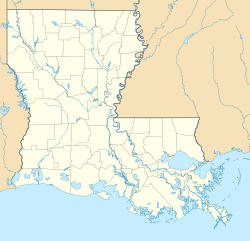Venable Mound facts for kids
| Location | Bonita, Louisiana, Morehouse Parish, Louisiana, |
|---|---|
| Region | Morehouse Parish, Louisiana |
| Coordinates | 32°54′3.9″N 91°46′29.4″W / 32.901083°N 91.774833°W |
| History | |
| Cultures | Troyville culture, Coles Creek culture, Plaquemine culture |
| Site notes | |
| Archaeologists | Benjamin Brodnax, Clarence Bloomfield Moore |
| Responsible body: private | |
Venable Mound is an ancient archaeological site located in Morehouse Parish, Louisiana, USA. It is named after Charles Venable. This site has a large mound that was built by early people who lived in the area long ago. It shows signs of three different ancient groups: the Troyville culture, the Coles Creek culture, and the Plaquemine culture.
What is Venable Mound?
Venable Mound is the last remaining mound from a larger group once known as the McTheney Mounds site. This site used to have three mounds. It is located near Bayou Bartholomew. Farmers have been using the land around the site since the 1850s.
Visiting Archaeologists
In the 1870s, an archaeologist named Benjamin Brodnax from the Smithsonian Institution visited the site. At that time, three mounds were still standing. Later, in 1908, another archaeologist named Clarence Bloomfield Moore came to the site. By then, only two mounds remained.
The Last Mound
The one mound that is still there today is a type called a platform mound. It is about 22 feet (6.7 m) tall. The base of the mound is about 140 feet (43 m) by 140 feet (43 m) square. The flat top of the mound measures about 50 feet (15 m) square.
Ancient Cultures at the Site
Archaeologists have studied the site to learn about the people who lived there. They found that the site was first used between 400 and 700 CE. This was during the time of the Troyville culture.
The main mound was built later, between 700 and 1200 CE. This period is known as the Coles Creek culture.
Scientists also found pottery and other items that show people lived at the site even later, from 1200 to 1541. This was during the Plaquemine culture and Mississippian culture periods.


